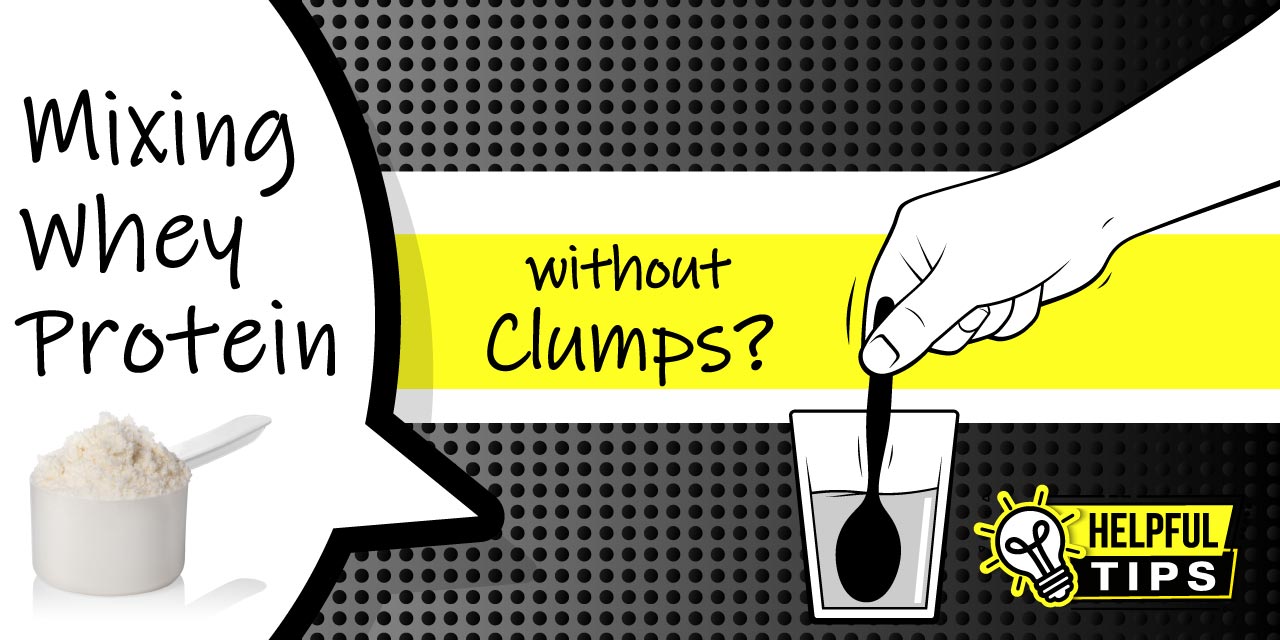How to Mix Protein Powder?

How to Mix Whey Protein?
In this article, we touch on several key factors that too often contribute to undesirable scenarios when reconstituting whey protein powder with water.
The information in this article has been gathered over many years through countless customer interactions in hopes of aligning expectations and gaining understanding so that working with whey protein powder in your daily routine doesn't involve forcing down clumpy lumps of frustration.
So that we begin this knowledge transfer on the similar ground please review the following definitions applied to the base case scenario mixing protein powder into water.
The protein powder is considered the solute.
The water is considered the solvent.
For the purposes of this article, when the solvent & solute combine to form a homogenous mixture that is distributed evenly, we refer to this as the solution and a victory.
The important take away here is that undenatured whey protein structures are hydrophilic and not capable of dissolving in any water-based liquid.
In the right conditions protein powder will disperse in a water based liquid. From a sensory point of view the difference chemically and physically between these two processes is negligible.
Whey Protein Mixing Tips
Solubility will Increase with 3 steps -
- Start with water at room temperature
- Increase the stir rate of the water
- Slow the rate of adding protein down
Tip: Add liquid first: Pour the liquid (water, milk, etc.) in your glass or shaker cup first, before adding the protein powder. This method will reduce the "caking" phenomena greatly and allow the protein powder to mix more easily and also prevent it from sticking to the container sides.
Does the Protein Quality impact Mixability?
When first opening your whey protein, based on how it moves and feels, you can determine with fair accuracy the moisture content. Moisture content is your best gauge as a consumer for determining the general quality of your whey protein (you can also message the manufacturer and ask).
The moisture content as a percentage of weight directly reflects the hierarchy of intent regarding the brand's basis of design.
In summary, higher quality dairy powders will carry high moisture content and will require a more nuanced approach for smooth mixing.
If the basis of the design includes removing nearly all of the water and fat to prohibit the growth of microorganisms, the final product will have the following enhanced features -
- Increased shelf-life
- Increased stability
- Increased resilience to high-temperature exposure
The sacrifice to create such a product with the above attributes is at the expense of the macro-nutrients generated from grass-fed dairy operations. However, if the source of origin is something other than grass-fed farming practices, the incentive to invest in a high-end nutrient preservation process (cold processing facility) is futile. This is to say, there is no point preserving nutrients that were never generated.
Note: Where micro-nutrients are vitamins and minerals, macro-nutrients are nitrogen-based superfoods that continue to gain traction in health and wellness. They include Beta-Lactoglobulin, Alpha-Lactalbumin, Immunoglobulins, Bovine Serum Albumin, Glycomacropeptide (GMP), and Lactoferrin.
As explained in detail in our cold-processing article, if nutrient preservation is a cherished production objective, the final product's moisture content will be reduced to 5%.
Learn More: What is Cold Processed Whey Protein?
To put this in perspective, the average moisture content for 99% of the whey products sold in the states under the Dietary Supplement Health & Education Act umbrella can be measured to be less than 2%.
Many brands will market "transparency" as their sole value while actively redacting the moisture content from the Certificates of Analysis & Composition.
To loosely gauge the moisture content without demanding the certificate of analysis if the product is unflavored, the process is very straightforward if the protein powder can easily create shapes similar to kinetic sand. If using a plastic scoop, can it be packed as if a scoop-shaped sand castle can stand tall against gravity without pouring like a bucket of Epsom? This type of behavior is indicative of moisture content between 4-6%.
Now that this concept is understood, It's easier to understand why friable masses, a.k.a. "lumps & clumps," are much more likely to occur when dairy powders are cold-processed to a moisture content hovering around 6%.
What Mixing Temperature is Best for Whey Protein?
Solubility & Dispersion increase for whey protein in water based solvents when the solution is mixed at room temperature. The further you deviate from ambient temperatures the more difficult it becomes.
How to Mix Whey in Hot Beverages?
Suppose adding dry protein powder into a hot solution like soup or coffee; a best practice is to "temper" the whey protein. The method leverages the tried and true concept of baking a cake or making a meringue (eggs).
Learn More: How to Bake with Whey Protein?
Tempering is a cooking technique that involves raising and lowering the temperature of a protein slowly and gradually, typically by adding a hot liquid to the protein mixture. This process can affect the protein differently, depending on the specific protein and the cooking method used.
Directions to mix in a hot beverage or soup -
- Take a small batch off to the side of the liquid and let it reach equilibrium with the ambient room temperature.
- Add your desired protein
- Mix thoroughly into this small batch to create a homogenous paste.
Following the above steps will ensure consistent water activity with the least energy across the whey. The resulting paste allows the addition of more water easily able to follow suit and dilute the solution further.
How to Mix Whey Without Clumps?
We discuss the phenomena of "caking" in more detail below. Still, for a fast answer, the best way to avoid lumpy clumping whey is to slowly add your dry whey into a minimal amount of solvent (liquid) and mix the resulting solution into a uniform paste free of lumps.
Consider this your starter batch, and continue adding more liquid until the desired consistency is achieved.
The goal is to wet all the solid particles individually before demanding they disperse in a body of liquid where saturation is likely to occur with some particles before other protein particles become surface wet.
When a spray-dried dairy protein becomes fully saturated with a water-based liquid it has a natural affinity to adhere to other fully saturated protein particles.
The idea to avoid caking is to reduce the solids concentration in the area of the dissolving whey particles. As whey protein rehydrates, if it is mechanically fixed into a position where other whey particles are concentrated (at the bottom of a shaker bottle), part of the whey in contact with the water phase of the liquid will render itself insoluble and create the non-permeable skin we want to avoid.
How to avoid a clumpy whey beverage?
- Increase the stir rate
- Increase the time it takes to add your whey into the mixture
Critical Notes: Time and patience are the keys to ensuring your whey protein powder reaches its dispersibility theoretical limit. Increasing the stir rate does not mean introducing turbulent flow jam-packed with air bubbles like a whisker ball.
Why Does Protein Powder Clump?
The food science phenomenon known as "caking" is what most in the nutrition and fitness industry would describe as "clumping" when mixing whey protein.
When dairy protein is spray dried, for the most part it takes an amorphous states and freely flows. The ability of protein powder to flow is a function of the moisture content; as discussed earlier in the article, when a plastic tub of protein is cooked to less than 2% moisture it flows like table salt.
If you can imagine building a sand castle, if the sand is bone-dry, it would not be able to hold any shape but respond predictably to void spaces and gravity.
As the protein powder is exposed to water, the mobility of the powder to flow starts to slow down as the powder undergoes a transition passed it's critical water activity point. During this transition, whey turns sticky and ultimately compacts into an agglomerated clump held together by cohesion forces.
By the time agglomerated clumps appear, the 3rd and 4th protein structures have begun to form a gel-like mesh capable of preventing fluid loss through the protein.
A water-proof blanket with a hydrophilic side facing out, while dry, unwet protein powder remains isolated on the adjacent side.
Caking occurs at the point where the wet protein powder no longer flows like sand and forms a barrier that is too agglomerated to allow the permeation of water, preventing water exposure to the remaining dry power.
"Clumping" wet and sticky whey is the product of fully saturating protein powder with a dry protein pocket on the opposite side of the impenetrable saturation blanket.
Best Blender for Protein Shakes?
The best blenders for mixing fragile dairy protein is one that offers a low-power mechanical shearing force that is gentle enough such that the protein structure is not battling air that is being forced upon it.
Unfortunately, most of us who do not have access to planetary centrifugal mixers capable of mixing liquid and powders together with complete uniformity and without air bubbles (in a vacuum).
What you most likely have is a counter-top blender with an assortment of blades or paddles that rely solely on high-powered mechanical shear designed to fold, blend, and chop even hard foods.
Mechanical shearing is the action of creating enough stress in a system by moving one surface over another causing displacements in the direction of the moving surface. Shearing is a critical force during mixing operations involving a liquid ands a powder. To remove this force would be a mistake and lead to caking.
When to use a blender or Whisker Ball?
Many brands out there chose not to add emulsifiers to their products. When chemical emulsifiers such as soy or sunflower lecithin are not being leveraged, the only option to create a smooth whey powder solution in water-based solutes is to apply large mechanical shearing forces.
Learn More: What is Sunflower Lecithin?
Are Whisker Balls Bad for Protein Shakes?
Whisker balls have gained traction over the years in helping athletes reconstitute their dry supplement powders into drinkable form. The shape of the whisker ball, with its many small wires or coils, helps to create additional friction and turbulence as it moves through the liquid. This can help break up clumps and ensure the mixture is evenly mixed.
Whisker balls are typically made from food-grade stainless steel or other metals. They are often small and portable, making them a convenient tool for on-the-go mixing.
Whisker balls, wire ball whisks, are small metal balls used to mix or froth liquids such as milk or protein shakes. They are often used as an alternative to a traditional whisk or blender.
The whisker ball creates turbulence and breaks up the liquid into tiny bubbles. As the whisker ball is moved around in the liquid, it agitates the mixture and incorporates air, creating a frothy texture.
Learn More: Mechanical Denaturation Impacts
Learn More: Denaturation of Whey & Bioavailability



